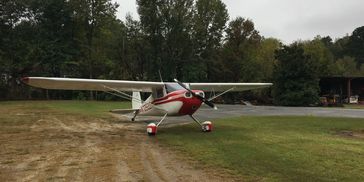the Taildragger

The Cessna 140
The 120 and 140 were some of the most successful postwar light aircraft in the US. The Cessna 140 was introduced in 1946, preparing to fill the need of the anticipated post-war boom of the aviation industry. Unfortunately, people weren’t rushing to buy airplanes like the manufacturers of the day thought they would. However, nearly 8,000 were built between 1946 and 1951, and more than 2,500 remain on the FAA register today.
The 120 was developed as a budget version of the 140, initially lacking flaps, rear side windows and electrical systems. All Cessna 120s and 140s originally had fabric wings, two steel struts and completely aluminum structure. A few have had the fabric replaced with metal.
"An affordable airplane to buy and operate, but its mission is fairly limited. It doesn’t have a lot of range or power, but it’d be a great trainer, and a ton of fun to fly if you work in the next town over, or take short weekend trips with a friend. It’s been described as docile and diminutive, but I think those words understate how enjoyable it can be to fly."

The Cessna 195 Business Liner is a single radial engine powered, conventional landing gear equipped, general aviation aircraft manufactured by Cessna between 1947 and 1954. The 195 model was also used by the United States Air Force, United States Army, and Army National Guard as a light transport and utility aircraft. "With an almost-cabin-class interior, the Cessna 195 opted for comfort and class over speed. The switches for flaps and lights took their cue from piano keys, protruding from the panel just under the instrument cluster. The trim wheel was of polished wood, and the steering yoke was centrally mounted, branching off to each pilot seat. Within the cabin, there was room to spare.
In production for seven years, Cessna constructed almost 1,200 of the 190 and 195s before their purchase price became prohibitive to purchasers and the line discontinued."

Radial Engines
Advantages :
Smoother operations: Radial engines are great at producing consistent power. This consistency helps the engine to run smoother.
Tougher & easier maintenance :
The simple design makes the radial engine less vulnerable to damage. Its also much easier to complete maintenance tasks and routine check-up.
Cost :
Radial engines’ parts, repair costs, & maintenance costs are inexpensive. in comparison to more modern engines.
Disadvantages :
Drag : As the cylinders are clearly exposed to the airflow during flight, drag increases considerably.
Visibility : The pilot may experience visibility problems during landings and when taxiing the plane due to the huge single engine located near the nose of aircrafts.
Cooling : It is more difficult to ensure adequate cooling air in a buried engine installation. Many radial engines rely on often messy oil-cooling.

Heritage Air Flight School offers taildragger certifications in a Cessna 140. Highly qualified pilots may rent the aircraft after a checkout.
Heritage Air Flight School
Airport Road Hangar 55 Midland, Virginia 22728, United States
(540) 402-KHWY